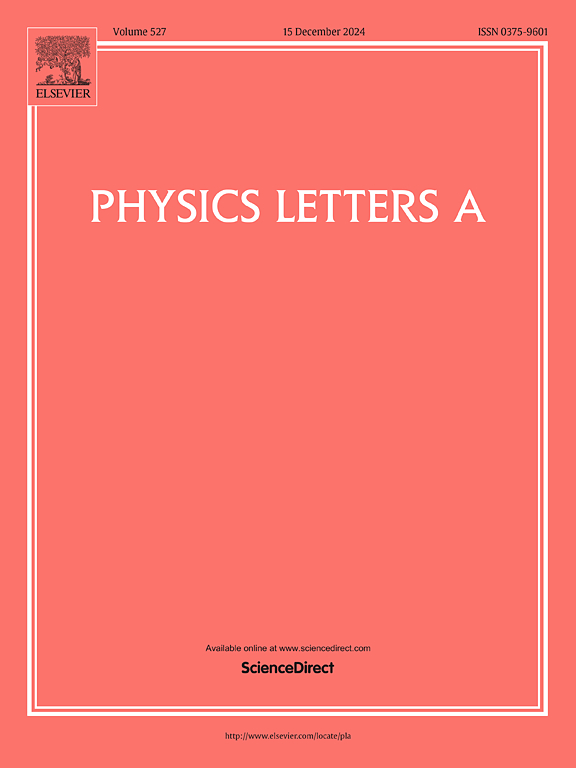The impact of community heterogeneity on information propagation and virus transmission in multi-layer networks
IF 2.3
3区 物理与天体物理
Q2 PHYSICS, MULTIDISCIPLINARY
引用次数: 0
Abstract
Community structures are ubiquitous in real-world networks, and community heterogeneity plays a pivotal role in the coupled dynamics of information propagation and virus transmission. Moreover, higher-order structures, such as 2-simplex, offer a novel theoretical framework for studying multi-node interactions. To explore these dynamics, a two-layer heterogeneous community network model is developed, where the upper layer represents information propagation dynamics, and the lower layer captures virus transmission processes. Through simulations, we investigate the impact of community heterogeneity and higher-order structures on propagation speed, threshold, and final scale. Results demonstrate that community heterogeneity significantly regulates the dynamics of information and virus propagation. We consider two scenarios where community heterogeneity exists in the upper and lower layers of the network. In both cases, networks with highly heterogeneous communities have a lower threshold than those with homogeneous communities. When community heterogeneity is present in the upper layer, the propagation scale of the highly heterogeneous community network is larger than that of the homogeneous network under the same virus transmission rate. In the case of heterogeneity in the lower layer, for lower virus transmission rates, the propagation scale of the highly heterogeneous community network is larger than that of the homogeneous network, while for higher virus transmission rates, the propagation scale of the highly heterogeneous community network is smaller than that of the homogeneous network. Additionally, higher-order structures play a crucial role in enhancing information propagation efficiency and suppressing virus transmission. This study provides new theoretical insights into propagation dynamics in complex networks and offers a foundation for optimizing public health interventions.
多层网络中群落异质性对信息传播和病毒传播的影响
社区结构在现实网络中无处不在,社区异质性在信息传播和病毒传播的耦合动力学中起着关键作用。此外,高阶结构,如2-单纯形,为研究多节点相互作用提供了新的理论框架。为了探索这些动态,建立了一个两层异构社区网络模型,其中上层表示信息传播动态,下层捕获病毒传播过程。通过模拟,我们研究了群落异质性和高阶结构对传播速度、阈值和最终规模的影响。结果表明,群落异质性对信息动态和病毒传播具有显著调控作用。我们考虑了两种场景,其中社区异质性存在于网络的上层和下层。在这两种情况下,具有高度异质社区的网络比具有同质社区的网络具有更低的阈值。当上层存在群落异质性时,在相同病毒传播速率下,高度异质性的群落网络的传播规模大于同质网络。在下层异质性的情况下,对于较低的病毒传播速率,高度异质的社区网络的传播规模大于同质网络,而对于较高的病毒传播速率,高度异质的社区网络的传播规模小于同质网络。此外,高阶结构在提高信息传播效率和抑制病毒传播方面起着至关重要的作用。该研究为复杂网络中的传播动力学提供了新的理论见解,并为优化公共卫生干预提供了基础。
本文章由计算机程序翻译,如有差异,请以英文原文为准。
求助全文
约1分钟内获得全文
求助全文
来源期刊

Physics Letters A
物理-物理:综合
CiteScore
5.10
自引率
3.80%
发文量
493
审稿时长
30 days
期刊介绍:
Physics Letters A offers an exciting publication outlet for novel and frontier physics. It encourages the submission of new research on: condensed matter physics, theoretical physics, nonlinear science, statistical physics, mathematical and computational physics, general and cross-disciplinary physics (including foundations), atomic, molecular and cluster physics, plasma and fluid physics, optical physics, biological physics and nanoscience. No articles on High Energy and Nuclear Physics are published in Physics Letters A. The journal''s high standard and wide dissemination ensures a broad readership amongst the physics community. Rapid publication times and flexible length restrictions give Physics Letters A the edge over other journals in the field.
 求助内容:
求助内容: 应助结果提醒方式:
应助结果提醒方式:


